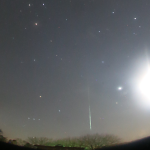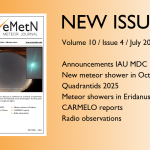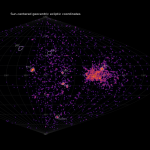Abstract: A summary of the activity of the CAMS BeNeLux network during the month of April 2020 is presented. 4128 orbits were collected during 29 nights with a maximum of 94 operational cameras at 25 different CAMS stations. Favorable weather circumstances during the Lyrid activity allowed to monitor the April Lyrid activity for a third year in a row.
1 Introduction
April is often a better month for astronomical observations after a general unfavorable first three months of the year. April also brings the Lyrids, a major annual shower with modest activity apart from some outbursts. CAMS BeNeLux got exceptional favorable observing conditions during the Lyrids 2018 and 2019, three years on a row may be too much to expect. Since March 2020 was an exceptional favorable record month the question was if the good weather would last longer into April?
2 April 2020 statistics
The weather remained stable during most of the month. As many as 16 nights had more than 100 orbits (8 in 2019), 4 nights more than 200 orbits (3 in 2019) and the record night was April 21–22 with as many as 460 orbits in a single night. Only one night, April 29–30 remained without any orbit. For a third year in a row, the CAMS BeNeLux network enjoyed clear sky during much of the Lyrid.
CAMS BeNeLux captured 24465 meteors (14667 in 2019) of which 14924 or 61% were multiple station (7894 and 54% in 2019). April 2020 resulted in a record number of 4128 orbits (2534 in 2019). This is the best score ever for the month of April in terms of orbits. The maximum of 94 cameras available improved compared to April 2019 (84 cameras). At least 76 cameras remained operational all nights, which is a lot better than the 44 cameras in April 2019 when several camera stations experienced technical issues. On average 89.4 cameras were operational, the highest score ever, against 67.7 in April 2019.
In total CAMS BeNeLux collected 12581 orbits during 210 April nights accumulated during the past 8 years. The statistics for April 2020 are compared in Table 1 with all previous months of April since the start of the CAMS BeNeLux network. Figure 1 shows the increase in number of operational cameras compared to previous years.
.

Figure 1 – Comparing April 2020 to previous months of April in the CAMS BeNeLux history. The blue bars represent the number of orbits, the red bars the maximum number of cameras running in a single night and the yellow bars the average number of cameras running per night.
Table 1 – April 2020 compared to previous months of April.
| Year | Nights | Orbits | Stations | Max. Cams | Min. Cams | Mean Cams |
| 2012 | 6 | 11 | 4 | 2 | 2.0 | |
| 2013 | 19 | 140 | 9 | 10 | 6.5 | |
| 2014 | 19 | 421 | 12 | 29 | 18.8 | |
| 2015 | 27 | 1212 | 15 | 43 | 33.9 | |
| 2016 | 26 | 971 | 17 | 50 | 15 | 37.0 |
| 2017 | 28 | 1235 | 20 | 60 | 32 | 48.2 |
| 2018 | 27 | 1929 | 21 | 83 | 59 | 73.3 |
| 2019 | 29 | 2534 | 20 | 84 | 44 | 67.7 |
| 2020 | 29 | 4128 | 25 | 94 | 76 | 89.4 |
| Total | 210 | 12581 |
3 Conclusion
April 2020 brought exceptional favorable weather for the CAMS BeNeLux network. Just like in 2018 and 2019 clear nights during much of the Lyrid activity period resulted in a record number of Lyrid orbits.
Acknowledgment
Many thanks to all participants in the CAMS BeNeLux network for their dedicated efforts. The data on which this report is based has been taken from the CAMS website[1]. The CAMS BeNeLux team is operated by the following volunteers:
Hans Betlem (Leiden, Netherlands, CAMS 371, 372 and 373), Felix Bettonvil (Utrecht, Netherlands, CAMS 376 and 377), Jean-Marie Biets (Wilderen, Belgium, CAMS 379, 380, 381 and 382), Martin Breukers (Hengelo, Netherlands, CAMS 320, 321, 322, 323, 324, 325, 326 and 327, RMS 328 and 329), Guiseppe Canonaco (Genk, RMS 3815), Bart Dessoy (Zoersel, Belgium, CAMS 397, 398, 804, 805, 806 and 888), Jean-Paul Dumoulin, Dominique Guiot and Christian Walin (Grapfontaine, Belgium, CAMS 814 and 815, RMS 003814), Uwe Glässner (Langenfeld, Germany, RMS 3800), Luc Gobin (Mechelen, Belgium, CAMS 390, 391, 807 and 808), Tioga Gulon (Nancy, France, CAMS 3900 and 3901), Robert Haas (Alphen aan de Rijn, Netherlands, CAMS 3160, 3161, 3162, 3163, 3164, 3165, 3166 and 3167), Robert Haas (Texel, Netherlands, CAMS 810, 811, 812 and 813), Robert Haas / Edwin van Dijk (Burlage, Germany, CAMS 801, 802, 821 and 822), Kees Habraken (Kattendijke, Netherlands, RMS 000378), Klaas Jobse (Oostkapelle, Netherlands, CAMS 3030, 3031, 3032, 3033, 3034, 3035, 3036 and 3037), Carl Johannink (Gronau, Germany, CAMS 311, 313, 314, 315, 316, 317, 318, 3000, 3001 and 3002), Hervé Lamy (Dourbes, Belgium, CAMS 394 and 395), Hervé Lamy (Humain Belgium, CAMS 816), Hervé Lamy (Ukkel, Belgium, CAMS 393), Koen Miskotte (Ermelo, Netherlands, CAMS 351, 352, 353 and 354), Jos Nijland (Terschelling, Netherlands, CAMS 841 and 842), Tim Polfliet (Gent, Belgium, CAMS 396), Steve Rau (Zillebeke, Belgium, CAMS 3850 and 3852), Paul and Adriana Roggemans (Mechelen, Belgium, CAMS 383, 384, 388, 389, 399 and 809, RMS 003830 and 003831), Hans Schremmer (Niederkruechten, Germany, CAMS 803) and Erwin van Ballegoij (Heesch, Netherlands, CAMS 347 and 348).




